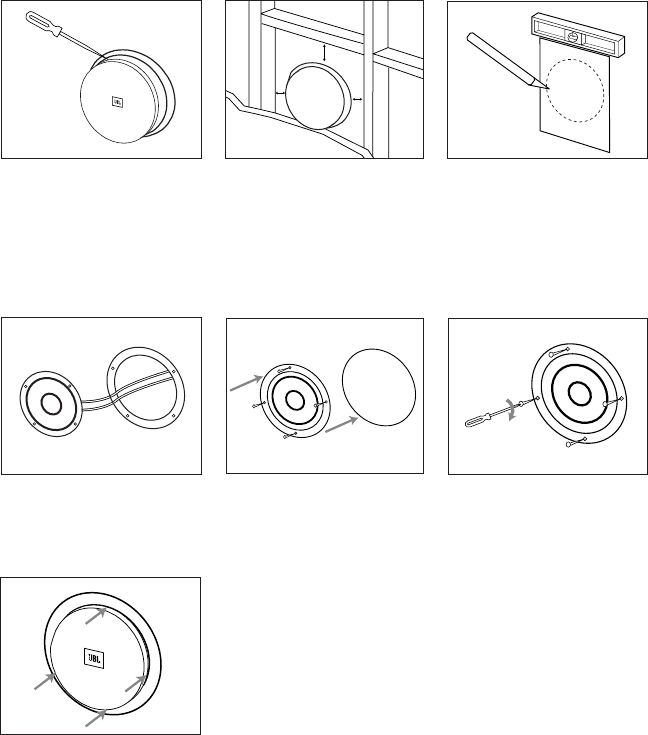
6
SP6C, SP8C
EXISTING CONSTRUCTION NEW CONSTRUCTION
PAINTING THE SPEAKER
FRAME AND GRILLE
Remove the grille from
the speaker frame.
≥1/2"
≥1/2"
≥1/2"
Cut the drywall.
Note: Always allow at least
one-half inch between a wall
stud and the speaker cutout or
the locking tabs will not be able
to swivel into place.
Connect the speaker wires
to the speaker.
Place the frame assembly
in the wall.
Screw down each of the four
Phillips head screws. The
locking tabs will swivel into
place and secure the unit to
the rear surface of the drywall.
Replace the metal grille.
Determine the correct speaker
location.
Note: Remove the inner template,
which is the paint shield, at the
perforation. Use the outer tem-
plate when cutting the drywall.
SoundPoint
™
Series loud-
speakers can be painted to
match any decor. If you wish
to change their color, the satin
finish on the grille and frame
will function as a primer coat.
Before painting, install the
paint shield (inner section of
template in the assembly kit)
securely into the recess in the
baffle. This will protect the
speaker components and baf-
fle from paint residue. Use a
high-quality spray paint, and
apply a thin coat of color.
Be certain the grille perfora-
tions remain free of paint.
Filling them with paint will
diminish the sound quality.
Note: Gently remove the
acoustical foam blanket from
the grille before painting.
Reattach the blanket after the
paint has dried.
You will need to purchase the correct rough-in frame kit for your model:
SPEAKER MODEL ROUGH-IN FRAME KIT
SP5 RIF5
SP6 RIF6
SP6C RIF6C
SP8 RIF8
SP8C RIF8C
Detailed installation instructions are supplied with the rough-in kit.
TROUBLESHOOTING
IF THERE IS NO
SOUND FROM ANY
OF THE SPEAKERS:
• Check that receiver/amplifier
is on and a source is playing.
• Check all wires and connec-
tions between receiver/ampli-
fier and speakers. Make sure
all wires are connected. Make
sure none of the speaker wires
are frayed, cut or punctured.
• Review proper operation of
your receiver/amplifier.
IF THERE IS NO SOUND
COMING FROM ONE
SPEAKER:
• Check the “Balance” control
on your receiver/amplifier.
• Check all wires and connec-
tions between receiver/ampli-
fier and speakers. Make sure
all wires are connected. Make
sure none of the speaker wires
are frayed, cut or punctured.
IF THERE IS LOW (OR
NO) BASS OUTPUT:
• Make sure the connections
to the left and right “Speaker
Inputs” have the correct polar-
ity (+ and –).
• Consider adding a powered
subwoofer to your system.
• In Dolby* Digital or DTS
®
modes, make sure your
receiver/processor is correctly
configured. When using a sub-
woofer, make sure the sub-
woofer output of the
receiver/processor has been
enabled. If no subwoofer is
being used, make sure the left
and right front and rear speakers
have been configured as
“LARGE.” See your
receiver/processor’s owner’s
manual for futher information
on correct speaker configura-
tion in Dolby Digital, DTS and
other surround-sound modes.
IF THE SYSTEM PLAYS
AT LOW VOLUMES
BUT SHUTS OFF AS
VOLUME IS INCREASED:
• Check all wires and connec-
tions between receiver/ampli-
fier and speakers. Make sure
all wires are connected. Make
sure none of the speaker wires
are frayed, cut or punctured.
• If more than one pair of main
speakers is being used, check
the minimum-impedance
requirements of your
receiver/amplifier.
7
Soundpoint OM SP5-6-6C-8-8 5/20/02 2:06 PM Page 6






